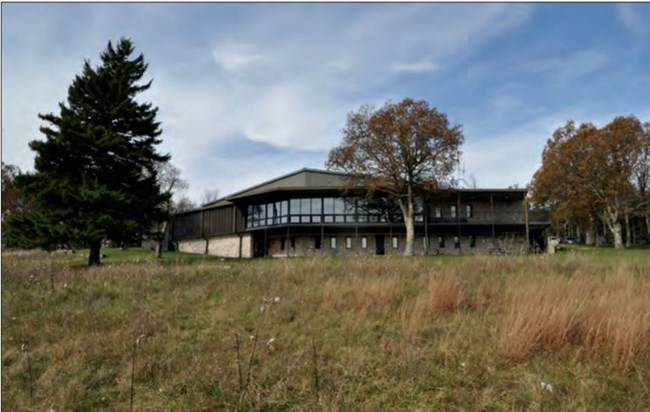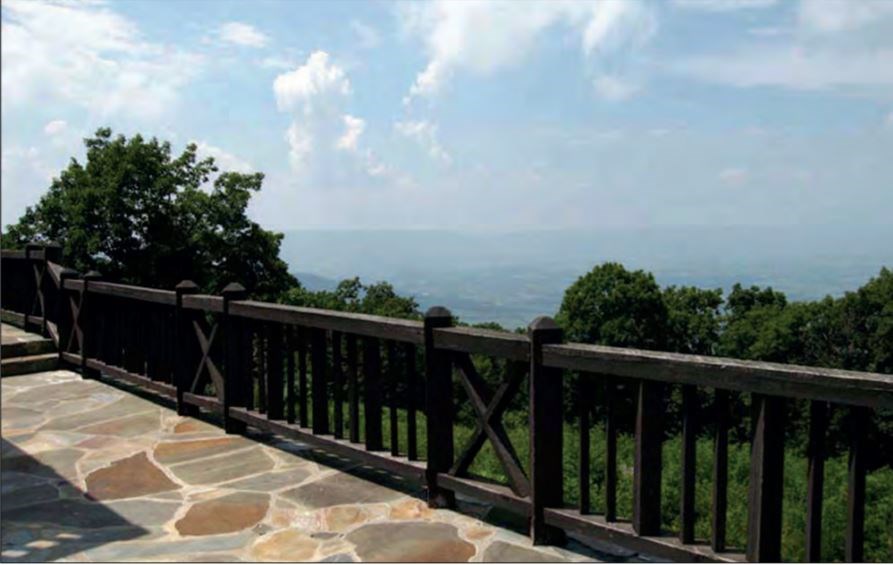Last updated: December 12, 2022
Article
Big Meadows Cultural Landscape

NPS
Civilian Conservation Corps (CCC)
Franklin D. Roosevelt established the Civilian Conservation Corps (CCC) to help relieve high unemployment and carry out a broad program of natural resource conservation on federal, state, and municipal lands. Six CCC camps were set up in Shenandoah National Park, including one at Big Meadows, Camp NP-2, later named Camp Fechner in honor of Robert Fechner, the Director of the CCC who died in 1939. The camp, housing about 200 men, extended from Milam Gap to Fishers Gap and north to the present Big Meadows campground.

NPS / Shenandoah National Park Archives
Camp Fechner began as a group of surplus tents, field kitchens, and latrines. More permanent buildings were soon constructed, including barracks, an infirmary, administration buildings, a garage, and a recreation building. The CCC laborers undertook a wide range of projects including erosion control, removal of dead chestnut trees, planting trees and shrubs, the construction of trails, shelters, and picnic areas with drinking fountains, tables, and fireplaces. The CCC also established a nursery at the northeastern edge of the meadow to propagate native vegetation for use in stabilizing cut and fill slopes and blending them into their surroundings as well as reducing soil erosion.
During the early 1930s, Big Meadows was designated a national soaring, or gliding, site to accommodate the growing popularity of sailplanes as a recreational activity. The CCC constructed a runway and a temporary hangar in the meadow for the use of the sailplanes, also called gliders.
Completion and Use of the Big Meadows Developed Area
In 1935, the NPS produced the first Master Plan for Shenandoah National Park, a landscape-scale plan that was revisited annually until 1940, including detailed plans for construction at Big Meadows. On July 3, 1936, President Roosevelt dedicated the new national park at Big Meadows. Over the next five years, the CCC, NPS, and the park’s new concessionaire---the Virginia Sky-Line Company (VSC)---constructed the picnic grounds and campground (CCC 1937), five cabins (VSC 1938), the Big Meadows Lodge and Wayside (VSC 1939), the planned maintenance area (NPS 1939), and employee housing (VSC 1941). Park and Concessionaire facilities were closed for most of World War II, and park usage expanded after the war from 1946-1949. Park use accelerated in the early 1950s, reflecting the post-war prosperity of the United States in general.Mission 66
During the late 1950s, the NPS underwent a comprehensive expansion and development program in order to meet the dramatic increase in visitation at the parks and to update existing facilities. Referred to as “Mission-66,” the program was planned to coincide with the fiftieth anniversary of the NPS in 1966. The Big Meadows campground was expanded with a new loop circulation and additional associated facilities, and new trails were constructed, such as the “Story of the Forest” Trail. Visitor centers were a major component of the Mission-66 initiative, envisioned as the center of the park interpretive program. At Big Meadows, the NPS constructed the Byrd Visitor Center, and associated parking lot, adjacent to the Wayside. The Visitor Center building was designed as a split-level structure with large plate glass windows overlooking the meadow. Additional housing for NPS employees was built at the maintenance area and concession employee residences were built nearby the cabin/lodge area.

NPS
National Significance
Big Meadows is nationally significant under National Register Criterion A in the areas of entertainment/recreation and politics/government for its association with Shenandoah National Park as one of the first eastern national parks.The site is associated with the early twentieth century movement to accommodate the growing popularity of the automobile while also conserving natural and scenic areas.
Big Meadows is also nationally significant under Criterion C in the areas of architecture and landscape architecture for its association with the rustic style developed by the NPS in the 1930s and 1940s. This style emphasized preserving restoring existing landscapes that had been altered by human hand to their original condition, using native vegetation. It also emphasized the incorporation of scenic views in the layout of buildings and circulation features and sited them to be as inconspicuous as possible. The NPS also encouraged the use of local materials and traditional methods in the construction of buildings, structures, and site furnishings. The overall layout of the Big Meadows developed area harmonized with the existing topography as much as possible and highlighted the views of the Shenandoah Valley and the meadow.

NPS
Maintaining the Landscape
The physical integrity of Big Meadows is evaluated by comparing landscape characteristics and features present during the period of significance (1931-1952) with current conditions. Many of the site’s historic characteristics and features remain unchanged. The site’s historic layout is still intact and features distinct areas grouped by function that include the wayside/visitor center, picnic grounds, lodge/cabin accommodations, campground, and maintenance facilities, and all which are connected by a primary access road. The historic rustic design is evident through the surviving circulation layout, materials, and vernacular building techniques reflecting the philosophy of a romanticized natural environment that was executed through the 1930s and 1940s.Treatment for Big Meadows is focused on enhancing the qualities that defined its character during the historic period and for which it is significant. Shenandoah National Park was authorized by Congress on May 22, 1926 along with Great Smoky Mountains National Park and Mammoth Cave National Park. The legislation states that the lands were “set aside as public parks for the benefit and enjoyment of the people….” Treatment for Big Meadows is also guided by the National Park Service Organic Act (1916), which establishes the National Park Service and defines its purpose “to conserve the scenery and the natural and historic objects and the wild life therein and to provide for the enjoyment of the same in such a manner and by such means as will leave them unimpaired for the enjoyment of future generations. Consistent with the philosophy that guided its original design and development, treatment of the Big Meadows cultural landscape will address the three complimentary goals of providing convenient services for visitors while protecting natural and cultural resources and perpetuating a scenic, natural visual experience. This will be accomplished through careful management of vegetation, including selective clearing and planting of vegetation, as well as the rehabilitation of site, soil, and plant communities. Maintenance practices will be adjusted to establish optimal growing conditions for the desired landscape character. Treatment will also include recommendations for compatible features and structures that provide necessary visitor services and accommodate park operations without detracting from the historic character. While it is impractical to restore the meadow to its former extent, the experience of the meadow landscape can be enhanced through strategic limited opening of forested areas and converting portions of turf grass to meadow vegetation.
In order to facilitate management of the Big Meadows cultural landscape, consolidate treatment efforts, establish priorities, and articulate historic character, the larger Big Meadows cultural landscape has been organized into six landscape management zones. These management zones are the lodge and cabin area, the campground and picnic area, the Wayside and Visitor Center, the maintenance area and employee housing, the roads and trails, and the meadow.

NPS
Quick Facts
- Cultural Landscape Type: Designed
- National Register Significance Level: National
- National Register Significance Criteria: A, C
- Period of Significance: 1931 to 1952
- National Historic Landmark (Skyline Drive Historic District)


